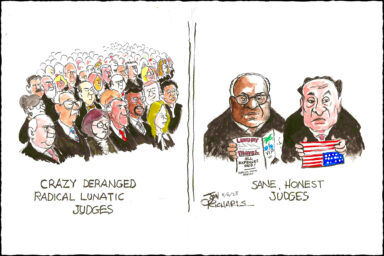Report from London: What Is a Coronation Anyway?
Making sense of the upcoming royal shindig.
|
Listen To This Story
|
A few days ago the following headline appeared on Page 3 of the London Evening Standard: “Fit for a king! It’s all aboard the Carolean Express.” The article breathlessly reported that a “high-speed train service from London to Edinburgh will be named to celebrate the reign of the King — and will start running on Coronation Day.”
That grand event is less than two weeks away, and it’s symptomatic of the supposedly historic occasion that it feels more proclamation than passion, with less interest in the “Carolean Express” than the Hogwarts one, famously boarded from Platform 9¾ at King’s Cross station.
The last coronation was 70 years ago, and it caught the fancy of much of the country, still suffering the indignity of rationing eight years after the war (it didn’t fully end until 1954).
As it happens, I have a small collection of books that celebrate mid-century British monarchical jubilees, coronations, and funerals. This interest dates to my childhood when I used to pore over a vast volume in my father’s library that collected a number of issues of the Sphere and Illustrated London News bound in funereal black leather and stamped on the spine “GEORGE V.”
The issues begin with coverage of the king’s silver jubilee in 1935, celebrating his quarter century on the throne, but soon report on his death just eight months later, and end with stories anticipating his son’s reign. (This turned out to be a truncated monarchy, not commemorated in the volume, as within a year Edward VIII had abdicated in favor of his younger brother George VI, a tabloid drama H.L. Mencken called “the best story since the Resurrection.”)
The photographs in the large, heavy book enthralled me with their Ruritanian pomp and grandeur, marking events that didn’t quite seem real. The picture of King George’s casket lying in state at Westminster Hall, guarded by eight figures in historical military costume, struck me as so unlikely and creepy that I was compelled to wait 10 hours in the legendary queue last year to see his late granddaughter Queen Elizabeth lying in an almost identical state 86 years later.
But the fascination with these rituals does not feel repeated for Charles’s succession.
The Palace-friendly press, such as the Daily Express and Daily Mail, has been feeding us regular bulletins about the upcoming festivities, many of them concerning the confected drama of the will-they-or-won’t-they-show-up Duke and Duchess of Sussex. (It ended in a split decision, with Harry resolved to put in an appearance and Meghan opting to stay home with the kiddies in California.)
One of the late queen’s most famous utterances was that the royal family “have to be seen to be believed.” That’s true on several levels: their job is to be visible enough to remind the populace of their existence, as well as to prove that the bizarre rituals and ceremonies aren’t just a figment of our imagination. There’s a lot of razzamatazz involved, which originated some centuries ago as a project to prove the monarch’s appointment from God.
The Guardian, by contrast, has published a series of articles informing us how much the royal family is costing us.
Between these two extremes (unction vs. dismissal) I suspect is where most of the country lies.
I asked my kids if there were any coronation-related events happening in their schools, and they couldn’t think of any. There was more excitement here when England reached the quarterfinals at the football (i.e., soccer) World Cup last year in Qatar.
That’s not to say there won’t be more festive hubbub closer to the event, but it’s getting pretty close.
What is a coronation anyway? Isn’t Charles already king? Yes, he ascended to the throne the minute his mother died on September 8, 2022.
The Royal Collection Trust informs us that the upcoming ceremony is “the formal investiture of a monarch with their regal powers. It is a grand, celebratory event in which the monarch is presented with royal ceremonial objects, such as the Crown Jewels, and it is where the crown is physically placed on the sovereign’s head, in front of many thousands of very important guests.”
Thus it can be seen as part sacrament, part Pinewood Studios. But the particulars of the event go back over a thousand years, picking up various elements since its launch in 973 for King Edgar’s coronation at Bath Abbey.
The coronation chair was added by Edward I to enclose the Stone of Scone, which was brought from Scotland to Westminster Abbey in 1296.
If the “Stone of Scone” sounds like something out of Harry Potter or Monty Python, it’s understandable; all three were spawned from a culture that has always been good at ritual and comedy, sometimes combining the two, intentionally or not.
The other props for the upcoming kegger — including the fabled crown jewels — date only to Charles II’s coronation, crafted for the restoration. (The original crown and scepter had been melted down by Oliver Cromwell after he’d won the Civil War and chopped off King Charles I’s head in 1649.)
The restoration of the monarchy in 1660 was such an important event that Charles II’s coronation had to dazzle. It was like a major Hollywood premiere, orchestrated to relaunch the production.
Each subsequent coronation has just had to refocus the nation’s attention on the latest occupant of the palace (itself an address that has changed over the years).
One of the late queen’s most famous utterances was that the royal family “have to be seen to be believed.” That’s true on several levels: Their job is to be visible enough to remind the populace of their existence, as well as to prove that the bizarre rituals and ceremonies aren’t just a figment of our imagination. There’s a lot of razzamatazz involved, which originated some centuries ago as a project to prove the monarch’s appointment from God.
 Thus, on May 6, the Archbishop of Canterbury will anoint the king with holy oil as part of a Communion service, a religious association that will be lost on much of this secular population.
Thus, on May 6, the Archbishop of Canterbury will anoint the king with holy oil as part of a Communion service, a religious association that will be lost on much of this secular population.
This areligious divide is such that the Archbishop of Canterbury was forced to deny any church tensions with the king, who was rumored to want to lessen some of the religious aspect of the service. “None whatsoever. No tension. Absolutely not,” claimed the senior cleric, insisting that the service would be “deeply Christian” and “representative of the people of this land.”
The lasting impact of the last couple of events may be in the many commemorative cups and saucers you still find in tea rooms and antique stalls across the country commemorating the coronations of King George VI and Queen Elizabeth II (I have a cracked Liz cup holding my pencils on my desk).
Recent ads have trumpeted similar commemorative ceramics for Charles’s jamboree (a bland-looking white Charles mug is yours for 25 quid ($31) from the Houses of Parliament shop), but I don’t see them flying off the shelves, any more than I imagine people taking the Carolean Express to Edinburgh will salute their king for the journey.
Still, the Monday after the coronation has been designated a special bank holiday, so if the weather’s nice, we’ll probably all head for the park. And if a note of appreciation is due, I’m happy to oblige.
Thanks, Charles, and hope you have a groovy shindig.
—
J.B. Miller is an American writer living in England, and is the author of My Life in Action Painting and The Satanic Nurses and Other Literary Parodies.




